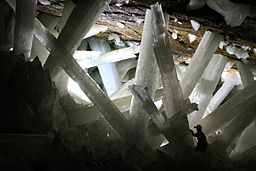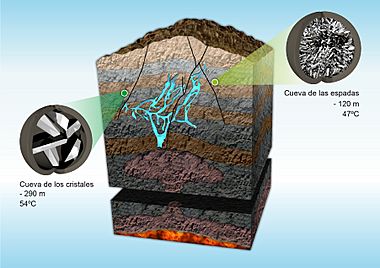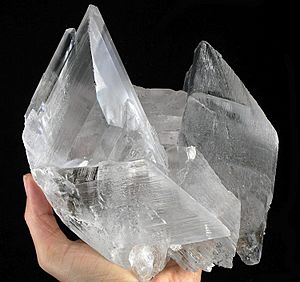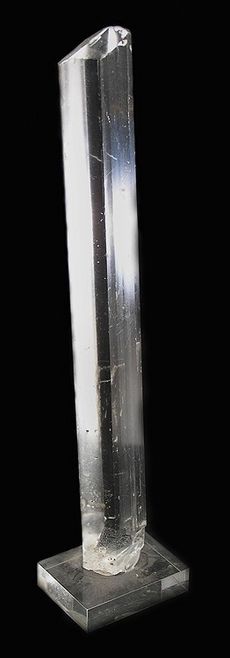Cave of the Crystals facts for kids
Quick facts for kids Cave of the Crystals |
|
|---|---|
| Cueva de los cristales | |

Gypsum crystals in the Naica cave. Note person for scale
|
|
| Location | Naica, Saucillo Municipality, Chihuahua, Mexico |
| Length | 109 m (358 ft) |
| Discovery | 2000 |
| Geology | Limestone |
| Hazards | High temperature and humidity |
| Access | Currently inaccessible |
The Cave of the Crystals or Giant Crystal Cave (Spanish: Cueva de los cristales) is an amazing cave found deep inside the Naica Mine in Chihuahua, Mexico. It's about 300 metres (980 ft) (almost 1,000 feet) underground! This special cave is a huge room carved into limestone rock. It's about 109 metres (358 ft) long, which is longer than a football field.
Inside, you'll find some of the biggest natural crystals ever discovered. These crystals are made of a mineral called selenite, which is a type of gypsum. The largest crystal is an incredible 11.40 metres (37.4 ft) long, weighing about 12 tonnes. That's like two elephants!
The cave is extremely hot and humid, with temperatures reaching up to 58 °C (136 °F) (136°F) and almost 100% humidity. Because of these harsh conditions, it's very hard to explore. People can only stay inside for about ten minutes without special protective gear.
Miners Juan and Pedro Sánchez discovered this cave in April 2000. As of October 2015, the mine has reflooded, meaning the cave is now filled with water again. This water is full of minerals, which is what helps the crystals grow even bigger. A group of scientists called the Naica Project has been studying these incredible caverns.
Contents
How the Giant Crystals Formed
The Naica area sits on top of a fault line, which is like a crack in the Earth's crust. Deep below the cave, about 3–5 kilometres (2–3 mi) down, there's a pocket of hot, melted rock called a magma chamber. This magma heated the water underground. This hot water was full of minerals, especially sulfur.
Cooler water from the surface slowly mixed with the hot, mineral-rich water. As oxygen from the cool water met the sulfur in the hot water, new minerals formed. These minerals then settled out as anhydrite crystals.
Over time, the cave's temperature slowly dropped below 56 °C (133 °F). When this happened, the anhydrite crystals began to dissolve. Then, the gypsum crystals (the giant ones we see today) started to form. These amazing crystals grew incredibly slowly, taking at least 500,000 years to reach their enormous size. It's one of the slowest crystal growth processes ever measured!
Discovering the Crystal Caves
The first crystal cave found in the Naica Mine was in 1910. Miners discovered the Cave of Swords (Spanish: Cueva de las espadas) about 120 metres (390 ft) (390 feet) deep. This cave has many beautiful crystals, but they are smaller, usually about 1-metre (3 ft 3 in) (3 feet) long. Scientists think that the temperature in this cave dropped faster, which stopped the crystals from growing as large as those in the Giant Crystal Cave.
The Giant Crystal Cave itself was found in April 2000. Miners working for the Industrias Peñoles company were digging a new tunnel. They were drilling through a fault line and accidentally broke into the amazing crystal chamber. The Naica mine is known for its large deposits of valuable metals like silver, zinc, and lead.
The Cave of Crystals is shaped like a horseshoe. Its floor is covered with perfectly shaped crystal blocks, and huge crystal beams stick out from the floor and walls. These crystals can get damaged by air, so the Naica Project worked hard to photograph and document them before they changed.
In 2000, two other smaller caves were also discovered: Queen’s Eye Cave and Candles Cave. Another chamber, called Ice Palace, was found in 2009. This new cave is 150 metres (490 ft) (490 feet) deep and is not flooded. However, its crystals are much smaller, looking like tiny "cauliflower" shapes and thin threads.
Exploring and Studying the Crystals
A team of scientists, led by Paolo Forti from the University of Bologna in Italy, explored the cave in 2006. Working in such extreme heat and humidity was a huge challenge. To survive, they had to create special refrigerated suits and cold breathing systems. Their suits had tubes filled with cold water and ice, connected to a backpack weighing about 20 kilograms (44 lb) (44 pounds). This cooling system gave them about half an hour to work inside the cave.
Besides studying the minerals and crystals, scientists also looked for signs of life. Stein-Erik Lauritzen from the University of Bergen used a special dating method to figure out the age of the giant crystals, which is about 500,000 years old. Another team measured how fast the crystals were growing today. They found they grow incredibly slowly, at a rate of about 1.4 nanometers per second. At this speed, the largest crystals would have taken around 1 million years to reach their current size!
Penelope Boston, a scientist who studies tiny organisms in extreme environments, took samples from inside the large crystals. She used sterile tools to drill small holes and look for ancient bacteria trapped inside the crystals' tiny fluid or solid pockets. In 2017, Dr. Boston and her team announced an amazing discovery: they found bacteria inside some of the crystals! They were able to bring these ancient organisms back to life, and they are unlike any known bacteria today.
Other research in the cave included studying pollen, the chemistry of the water, and the overall conditions inside the Cave of Crystals.
The Cave's Current Status
The Cave of the Crystals has been featured on TV shows like the Discovery Channel's Naica: Beyond The Crystal Cave and the History Channel's Life After People.
For the cave to be accessible, the mine's water pumps had to keep the water out. However, when mining operations stopped in October 2015, the pumps were turned off, and the caves were allowed to re-flood. This means the crystals are now submerged in water again, which is good for their continued growth.
According to a report from February 2019, if the mining company decides to open another entrance, researchers might be able to go back in and continue their important work.
See also
 In Spanish: Cueva de los cristales (Naica) para niños
In Spanish: Cueva de los cristales (Naica) para niños
- Nombre de Dios Grottoes




